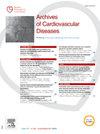Impact of elevated transmitral mean gradient on cardiovascular outcomes after transcatheter mitral valve implantation
IF 2.2
3区 医学
Q2 CARDIAC & CARDIOVASCULAR SYSTEMS
引用次数: 0
Abstract
Background
Transcatheter mitral valve implantation (TMVI) has emerged as an alternative to surgery in high-risk patients with failing mitral bioprosthesis (valve-in-valve) or annuloplasties (valve-in-ring).
Objectives
We aim to evaluate the prognostic impact of an elevated mean gradient > 5 mmHg after the procedure.
Methods
Patients undergoing TMVI from 2010 to 2024 were classified in three groups according to mean gradient after the procedure: Group 1 < 5 mmHg, Group 2 between 5 and 10 mmHg and Group 3 ≥ 10 mmHg.
Results
Among the 175 patients included, indications for TMVI were bioprosthesis failure in 131 patients (74.9%) and ring annuloplasty failure in 44 patients (25.1%), with a median age of 69 (52.5–80) and 155 (88.6%) in NYHA class III or IV. 50 patients were in group 1, 111 in group 2 and 14 in group 3, without any difference in baseline characteristics except for age (P = 0.02) and hemoglobin level (P < 0.001) or procedural findings. At 30 days, the rates of all-cause mortality and rehospitalization for heart failure were similar in the three groups. At a median follow up of 3 years, 43 patients have died (35 for cardiovascular reasons) with a cumulative rate of all-cause mortality at 1 and 2 years of 18.7% and 19.2% respectively. The presence of an elevated mean gradient was not associated with increased risk of mortality (HR 1,11 (0.93–1.31), P = 0.25) but associated with an increase risk of cardiovascular mortality with a HR of 1.22 (1.05–1.42), P = 0.01) and of heart failure (1.15 (1.01–1.31), P = 0.04). At one year, an improvement of NYHA class was observed in the two groups with mean gradient < 10 mmHg (P < 0.01) compared to baseline without any difference for the group 3 (P = 0.33). Median sPAP also significantly improved in groups 1 and 2 (P < 0.01) compared to baseline without improvement in group 3 (P = 1) (Figure 1, Figure 2).
Conclusion
An elevated mean gradient post-TMVI ≥ 10 mmHg was associated with cardiovascular death and hospitalization for heart failure, without significant functional improvement.
经导管二尖瓣置入术后平均梯度升高对心血管预后的影响
背景:经导管二尖瓣植入术(TMVI)已成为二尖瓣生物假体(瓣膜内瓣膜)或环成形术(瓣膜内环)失败的高危患者手术的替代方法。目的:评估平均梯度升高对预后的影响;5毫米汞柱。方法根据术后平均梯度将2010 ~ 2024年TMVI患者分为3组:第一组和第二组;2组在5 ~ 10mmhg之间,3组≥10mmhg。结果175例患者中,TMVI的适应症为生物假体失败131例(74.9%),环成形术失败44例(25.1%),NYHA III或IV级患者中位年龄分别为69例(52.5 ~ 80)和155例(88.6%)。第1组50例,第2组111例,第3组14例,除年龄(P = 0.02)和血红蛋白水平(P <;0.001)或程序检查结果。在30天,三组的全因死亡率和心力衰竭再住院率相似。在中位随访3年期间,43例患者死亡(35例死于心血管原因),1年和2年的累积全因死亡率分别为18.7%和19.2%。平均梯度升高与死亡风险增加无关(HR 1,11 (0.93-1.31), P = 0.25),但与心血管死亡风险增加相关(HR 1.22 (1.05-1.42), P = 0.01),与心力衰竭风险增加相关(HR 1.15 (1.01-1.31), P = 0.04)。一年后,两组NYHA评分均有改善,平均梯度<;10 mmHg (P <;0.01)与基线相比,第3组无差异(P = 0.33)。第1组和第2组的中位sPAP也显著改善(P <;0.01),与基线相比,3组无改善(P = 1)(图1,图2)。结论tmvi术后平均梯度升高≥10 mmHg与心血管死亡和心力衰竭住院相关,无明显功能改善。
本文章由计算机程序翻译,如有差异,请以英文原文为准。
求助全文
约1分钟内获得全文
求助全文
来源期刊

Archives of Cardiovascular Diseases
医学-心血管系统
CiteScore
4.40
自引率
6.70%
发文量
87
审稿时长
34 days
期刊介绍:
The Journal publishes original peer-reviewed clinical and research articles, epidemiological studies, new methodological clinical approaches, review articles and editorials. Topics covered include coronary artery and valve diseases, interventional and pediatric cardiology, cardiovascular surgery, cardiomyopathy and heart failure, arrhythmias and stimulation, cardiovascular imaging, vascular medicine and hypertension, epidemiology and risk factors, and large multicenter studies. Archives of Cardiovascular Diseases also publishes abstracts of papers presented at the annual sessions of the Journées Européennes de la Société Française de Cardiologie and the guidelines edited by the French Society of Cardiology.
 求助内容:
求助内容: 应助结果提醒方式:
应助结果提醒方式:


